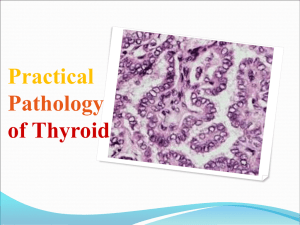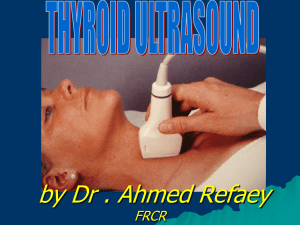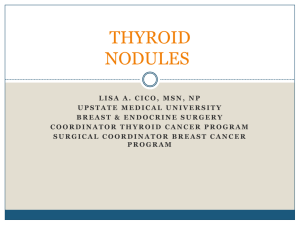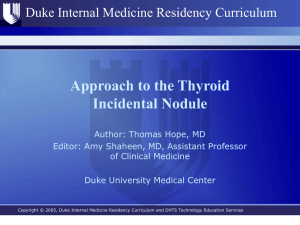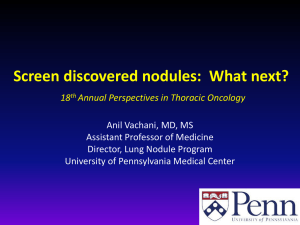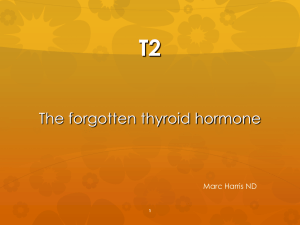Thyroid - EventBuilder
advertisement
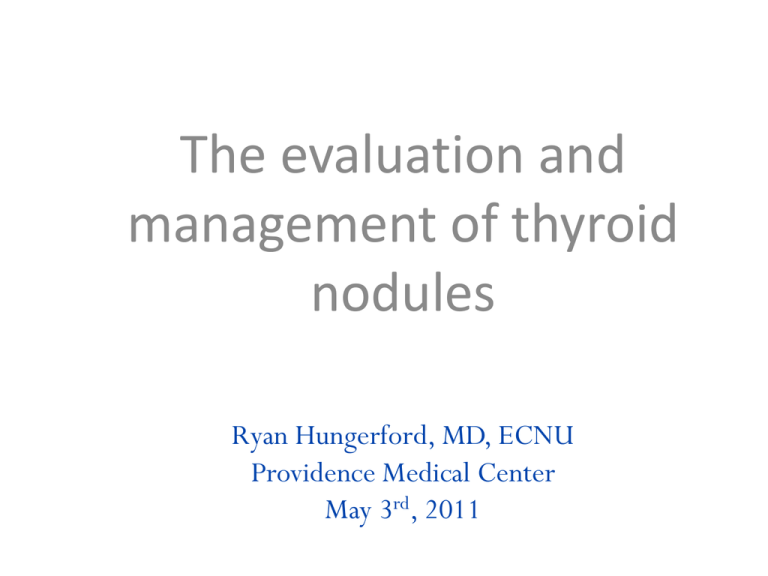
The evaluation and management of thyroid nodules Ryan Hungerford, MD, ECNU Providence Medical Center May 3rd, 2011 Marie de Medici By Peter Paul Rubens, 1622 Goiter considered fashionable Thyroid glands are beautiful • In 1656, Thomas Wharton, English physician and anatomist, is credited with naming the thyroid gland: • “glandulae thyroideae”… – whose purpose is to beautify the neck…particularly in females to whom for this reason a larger gland has been assigned.” Well, maybe some goiters aren’t quite as attractive! Thyroid Nodules Benign (92-96%) • Adenomas (Follicular or Hurthle cell) • Focal thyroiditis • Thyroid, parathyroid, or thyroglossal cysts • Thyroid hemiagenesis • Postsurgical or postradioiodine remnant hyperplasia • Rare: teratoma, lipoma, hemangioma Malignant (4-8%) • Well-differentiated (96%) – Papillary – Follicular (includes Hürthle) – Medullary • Undifferentiated (3%) – Anaplastic • Miscellaneous (1%) – Lymphoma, SCC, metastatic carcinoma, etc. Thyroid cancer • In general, thyroid cancer is a slow-growing, treatable, often curable, disease with a low mortality rate* – ~98% 10-year mortality for PTC • Unfortunately, recurrences are common and a nonnegligible number of patients will experience: – Progressive disease with regional spread to cervical or mediastinal lymph nodes – Pulmonary or skeletal metastases – Cerebral metastases – Death (often from respiratory failure) • In 2010: – 44,670 people were diagnosed with thyroid cancer – 1,690 people died *does not apply to poorly-differentiated cancer, such as anaplastic thyroid ca Thyroid cancer incidence is rising1,2 1975 • Incidence 2007 • Incidence – 4.85 cases per 100,000 • Mortality – 11.99 cases per 100,000 • Mortality – 0.55 deaths per 100,000 – 0.47 deaths per 100,000 2.4 fold increase in thyroid cancer incidence 1Davies. JAMA 2006;295:2164. 2NCI Surveillance, Epidemiology and End Results (SEER) RED= rising incidence Data from the National Program of Cancer Registries (NPCR) and National Cancer Institute using SEER database. Conclusions: the increased incidence of thyroid cancer is due to “overdiagnosis” of subclinical disease 49% of the increased incidence attributable to small (<1cm) papillary thyroid cancers 1Davies. JAMA 2006;295:2164. There is more to this story… • If the higher incidence is exclusively attributable to detection… • then it would be expected that only the number of patients with smaller tumors and early-stage disease would be increasing. Larger, more aggressive tumors: Incidence also rising Morris study (Am J Surg 2009) • SEER database since 1983 • Tumors >4cm – All showing rising incidence – About 5% annual % ↑ • Extrathyroidal extension – 0.8 per 100,000 (1983) – 1.7 per 100,000 (2006) Chen study (Cancer 2009) • SEER database since 1983 • Increased incidence in localized, regional and distant stage tumors • Rates of distant mets have risen from 4% to 9% • Lymph node mets – 1.0 per 100,000 (1983) – 2.9 per 100,000 (2006) Increasing thyroid cancer incidence not just “overdiagnosis” of subclinical disease! <1cm 1.0-2.9cm 3.0-3.9cm >4cm 1.0-2.9cm 3.0-3.9cm >4cm Female <1cm Male Chen. Cancer 2009;115:3801. Thyroid nodules: epidemiology • In the United States, 4 to 7% of the adult population have a palpable thyroid nodule – ~100-150 million Americans have thyroid nodules (u/s + P) – 300,000 new nodules identified in 2010! – Incidental discovery increasing1 with widespread use of CT, MRI, carotid u/s, PET 2 • More common in women, and increased incidence with age – If you are a 60 y/o female, there is a 50% chance you have a thyroid nodule – By some estimates, it is more common to have a nodule than to not have a nodule! • Only 1 of 20 clinically identified nodules is malignant 1Am J Neuroradiol 1997;18:1423. 2 J Nuc Med 2006;47:609. Case #1: “They found a nodule in my thyroid gland” • 50 year old female presents for evaluation of neck pain following whiplash from a car accident • CT scan of the neck was performed • Radiology report: – “Right thyroid lobe contains an ill defined nodule which is inadequately evaluated by this examination. Malignancy cannot be ruled out and a dedicated US study is recommended.” • Now what? Basic approach to a thyroid nodule 1. 2. 3. 4. 5. History Physical Neck Ultrasound TSH Decision to FNA based upon above data Perform a good history Emphasis: thyroid cancer risk factors • Relevant family history – First degree relative with thyroid cancer • The “sister factor” Especially a sibling (6x ↑ risk) or a sister if you are female (11x ↑ risk) – Family history of multiple endocrine neoplasia (MEN) 2, Carney complex, Cowden’s syndrome • Age and gender – Male gender and extremes of age (<14 or >70) associated with ↑ risk of malignancy • Radiation exposure – History of childhood head and neck irradiation (acne, tonsils, thymus, tinea capitis, etc.)1 – History of BM transplantation with whole body irradiation – Exposure to ionizing radiation from fallout (in childhood or adolescence), i.e. Chernobyl • Relevant symptoms – – – – Rapid growth of nodule (if palpable) or palpable cervical lymph nodes Hoarseness The three “Ds”: dysphagia, dyspnea, dysphonia Symptoms of thyrotoxicosis (palpitations, tremor, etc.) more s/o toxic nodule 1Otolaryngol Head Neck Surg 1996;115:403. Prevalence of malignancy in relation to patients' age in years increased prevalence in patients at the extremes of age Boelaert, K. et al. J Clin Endocrinol Metab 2006;91:4295-4301 Nuclear fallout • Chernobyl, 1986 • Estimated that 60% of nuclear fallout landed in Belarus • Thyroid cancer incidence rose dramatically, remains elevated to present day >6,000 cases of thyroid cancer diagnosed as of 2005 among children/adolescents exposed in Belarus, Ukraine, Russia The developing thyroid gland is very sensitive to radiation Chernobyl incident USA Today, April 26th, 2011 Perform a focused physical examination emphasis: lymph nodes • Examine neck for palpable nodule(s) and enlarged cervical lymph nodes – Particular concern if fixed, hard mass • Palpation vs. ultrasound – ~40% of nodules >2cm are MISSED by palpation!1 – Using ultrasound, about 15% of patients will have an additional non-palpable nodule >1cm, and 15% will have no nodule at all!2 • For most patients with known or suspected thyroid nodules, the physical examination is not particularly useful! 1Brander 2Tan et al. J Clin Ultrasound 1992;20:37. GH et al. Arch Intern Med 1995;155:2418. Covered so far…. 1. History 2. Physical 3. Neck Ultrasound 4. TSH 5. Decision to FNA based upon above data ATA thyroid cancer guidelines 2009;Thyroid;19:1167. Screening ultrasound not appropriate for fatigue, hypothyroidism, or elevated TPO antibodies AACE/AME/ETA Thyroid Nodule Guidelines, Endocr Pract. 2010;16(Suppl 1) Nodule features by Ultrasound More likely benign • Iso- or Hyperechoic • Smooth borders • Halo • Uninterrupted Peripheral or “eggshell” calcifications • Low vascularity • Soft (elastic) More likely malignant • Hypoechoic • Irregular borders • No halo • Microcalcifications • tall>wide • High vascularity • Hard (not elastic) There is no single pathognomic finding that confirms malignancy or benignity. Normal thyroid gland Normal thyroid Colloid artifact Benign cyst Well-defined borders Irregular borders Microcalcifications Microcalcifications Hypoechoic Taller than wide Hypoechoic Hypervascular Not a cyst! This is a parathyroid adenoma PTH dropped from 31040 after removal Nodule features by Ultrasound More likely benign • Hyperechoic • Smooth borders • Halo • Uninterrupted Peripheral or “eggshell” calcifications • Low vascularity • Soft (elastic) More likely malignant • Hypoechoic • Irregular borders • No halo • Microcalcifications • tall>wide • High vascularity • Hard (not elastic) Ultrasound Elastography • Malignant lesions are associated with changes in the mechanical properties of a tissue • Elastography is a dynamic technique that uses ultrasound to provide an estimation of tissue stiffness by measuring the degree of distortion under the application of an external force • Has been used to differentiate cancer from benign lesions in prostate, breast, pancreas, LNs • Now being applied to thyroid nodules 92 consecutive patients who underwent surgery for solitary thyroid nodules -all underwent standard thyroid ultrasound, standard risk assessment -Elastography was performed for all nodules -nodules “scored” based on how “ELASTIC” they are Rago. J Clin Endocrinol Metab 2007;92:2917-2922. Elasto study findings • 92 cases, all proceeded to surgery, known histologic diagnosis – 34% malignant – 66% benign • Elastography – Score 1-2 identified in 49 patients: all benign – Score 3 identified in 13 patient: 1 malignancy, 12 benign – Score 4-5 identified in 30 patients: all malignant • Conclusions – If your thyroid nodule is very elastic (score 1-2), it is most likely benign – If your thyroid nodule is very firm (score 4-5), it is most likely cancer • Elastography is of tremendous clinical value, particularly when added to other standard US sonographic features – Limitations: can’t be used on cystic/solid nodules or calcified nodules Rago. J Clin Endocrinol Metab 2007;92:2917-2922. Elastic: Score 1 Hard: Score 5 Should I do any lab testing for a thyroid nodule? • TSH for everybody! – If low, don’t biopsy! (To be reviewed in next few slides) • TPO and TG antibodies usually NOT necessary – But, TPO abs may help determine the explanation for other sonographic findings (ex: Hashimoto’s) – ↑ TG abs associated with thyroid cancer, hypothesis: thyroid inflammation is tumorigenic or abnormal TG expressed by tumor cells triggers immune response • A serum TSH is Elevated in Medullary Thyroid Cancer (3-5% of thyroid malignancies) and C-cell hyperplasia and may help detect MTC at an earlier stage indicated inscreening all inpatients Some recommend universal calcitonin patients with nodules with thyroid nodules Calcitonin – – • • • • American Thyroid Association (2009) guidelines: recommendation I AACE, AME, European Thyroid Association: “consider” Always measured if family history of MTC or MEN2 Thyroglobulin – Not useful, no relationship to thyroid malignancy – Universal consensus among all professional societies (ATA, AACE, AME, ETA) – Do NOT measure! AACE/AME/ETA Thyroid Nodule Guidelines, Endocr Pract. 2010;16(Suppl 1). ATA guidelines for management of thyroid nodules and thyroid cancer, Thyroid, 2009;19(11):1167. Why is the TSH so useful? • It helps determine if the nodule is likely to be a “toxic” adenoma – These are autonomous, hyperfunctioning nodules, aka “hot” nodules – They are [almost] always benign! – Thus, FNA is usually* unnecessary – If the TSH is low, patient should be sent for a radionuclide study first and/or referred to endo Important: thyroid uptake and scan is not appropriate for MOST patients with thyroid nodules! *if nodule is smaller (<1.5 or so) with suspicious features, FNA may still be indicated Does TSH correlate with risk of malignancy in a patient with a nodule? • Prospective study of 1,183 patients with palpable thyroid enlargement • All had FNA and/or surgery • TSH measured at presentation, then compared to FNA and/or surgical findings Boelaert K. J Clin Endocrinol Metab 2006;91(11):4295. Risk of thyroid cancer increases as TSH rises Boelaert, K. et al. J Clin Endocrinol Metab 2006;91:4295-4301 Estimated probability of malignancy in 40 y/o female with a solitary thyroid nodule Why? TSH Risk of cancer_ TSH has a trophic effect on thyroid cancer 0.3 8% growth, likely mediated by TSH receptors on 0.5 8.4% tumor cells. 1.0 9.4% TSH suppression is an independent predictor 3.0 14.6% of relapse-free survival from differentiated 5.0 21.9% thyroid cancer. 6.0 26.4% Boelaert, K. et al. J Clin Endocrinol Metab 2006;91:4295-4301 Test: true or false? • The larger the nodule, the more likely it is to be cancer. • A patient with a solitary nodule is more likely to have cancer than a patient with multiple nodules (multinodular goiter). • Treatment with levothyroxine will shrink thyroid nodules. Nodule features by Ultrasound More likely benign • Hyperechoic or isoechoic • Smooth borders • Halo • Uninterrupted Peripheral or “eggshell” calcifications • Low vascularity • Soft/elastic More likely malignant • Hypoechoic • Irregular borders • No halo • Microcalcifications • tall>wide • High vascularity • Hard/not elastic No mention of size! Malignancy rate was not lower (was actually higher) in nodules <1cm 520 consecutive thyroid nodules evaluated from 2003-2006. Group 1: subcentimeter nodules (N=247) Group 2: supracentimeter nodules (N=273) Ultrasound and FNA for all patients; malignant or suspicioussurgery Berker. Thyroid 2008;18:603-608. Size does not predict risk of malignancy US guided FNA in 402 pts with non-palpable nodules Nodule 10 mm Nodule >10 mm 9.1% cancer 7.0% cancer Papini E et al. J Clin Endocrinol Metab 2002:87:1941-1946 Cancer risk: Solitary vs Multiple Cohort n McCall et al 442 (1986 U.S.) Cochand-Priolett et al 132 (1994 France) Sachmechi et al 443 (2000 U.S.) Marqusee et al 156 (2000 U.S.) Papini et al 494 (2002 Italy) Deandrea et al 420 (2002 Italy) Frates et al 1,985 (2006 U.S.) Imaging modality Scan/Hx FNA Cancer risk as % Single Multiple Palpation 17 13 Scan/US US guided 13 14 NM Scan Palpation 8 10 US US guided 7 9 US US guided 9 6 US US guided 6 7 US US guided 14.8 14.9 Levothyroxine to shrink nodules • Systematic review of 6 highest quality RCT evaluating the efficacy of LT4 suppressive therapy (>50% vol reduction) • 5 of 6 studies: no statistically significant benefit, though a trend toward nodule volume reduction was seen The use of LT4 to • It is possible that a subgroup of patients, not thyroid nodules identifiable shrink based on pre-treatment characteristics, benefit hascould fallen out of favor • Must consider potential skeletal and cardiac risks of TSH suppression Gharib. N Engl J Med 1987;317:70. Castro. J Clin Endocrinol Metab 2002;87:4154. Gharib. Ann Intern Med 1998;128:386. Post test • The larger the nodule, the more likely it is to be cancer. False • A patient with a solitary nodule is more likely to have cancer than a patient with multiple nodules (multinodular goiter). False • Treatment with levothyroxine will shrink thyroid nodules. False Fine needle aspiration (FNA) • Most accurate, cost-effective means to assess The objective of the FNA risk of malignancy in a thyroid nodule • Highly accurate in identification malignancy is to select patientsofwho – Sensitivity ~95% highersurgery willorneed – Specificity ~85% or higher – Note: false negatives (FNA positive for malignancy, but negative histologic findings) do occur (~5%), but are relatively uncommon • In general, FNA findings are very reliable The biopsy (FNA): How it’s done • Simple in-office procedure – – – – Some use local anesthesia (1% Lidocaine), I do not Patient prepped with alcohol (“clean,” not sterile, procedure) Usually 25-27g needle, perpendicular or parallel approach 2 passes, sometimes 3-4, more usually does not ↑ diagnostic yield • Most patients report minimal or no pain – Bruising, bleeding rare (can be done on coumadin) – Infection almost unheard of (case reports outside U.S.) – Patient can go home or back to work, call if swelling • Post-procedure – Aspirate smeared on slides, sent to pathology – Some endocrinologists stain slides (Diff-Quik) and assess adequacy by light microscopy prior to sending slides to pathology, and repeat the procedure if insufficient cellular material – I do this for every FNA Pathology Findings • Benign (~65-70%) • Indeterminate (~10-20%) – Atypia or follicular lesion “of undetermined significance” – Follicular or Hürthle cell neoplasm • Malignant or suspicious for malignancy (~5%) • Non-diagnostic (aka insufficient) (10-15%) Gharib, Papini. Endocrinol Metab Clin North Am 2007;36:707. When should FNA be performed? • >5mm if high risk history (regardless of sonographic features) – Family history of thyroid cancer, especially MTC – Calcitonin >100pg/mL – History Indication of external beam irradiation or ionizingon radiation to the neck as for FNA depends the a child or adolescent – Prior hemithyroidectomy with malignancy clinical risk factors and sonographic – 18FDG avidity on PETof scanning features the nodule and cervical • 1-2cm depending on presence or absence of suspicious sonographic lymph nodes features (microcalcifications, hypoechogenic, etc.) • ≥2cm if spongiform, >50% cystic, no suspicious sonographic features • A couple exceptions: – NEVER if purely cystic, regardless of size – ALWAYS if abnormal cervical lymph nodes ATA guidelines for management of thyroid nodules and thyroid cancer, Thyroid, 2009;19(11):1167. Important conclusions: The decision to perform FNA can NOT be made without a focused medical history and can NOT be made without high quality ultrasonography with lymph node evaluation. AACE/AME/ETA Thyroid Nodule Guidelines, Endocr Pract. 2010;16(Suppl 1) Lymph node evaluation • Presence of malignant-appearing lymph nodes dramatically alters FNA threshold • Many sonographers are not comfortable with detailed LN evaluations, it is not currently part of the sonographer training curriculum • If pathologic LNs are identified, this changes the surgery! Thyroid, 2009;19(11):1167. ECNU • “Endocrine Certification in Neck Ultrasound” • Recognized by the American Institute of Ultrasound in Medicine (AIUM), the preeminent national accreditation body for u/s practices Why can’t we just FNA all nodules? • Diagnostic possibilities from FNA – – – – Non-diagnostic (insufficient) Benign Indeterminate, follicular neoplasm Malignant or suspicious for cancer • When FNA is performed, depending on quality of cytology, there is a 10-30% chance that the patient will be sent for surgery • The majority of “indeterminate” cytology findings turn out to be benign by histology Massive numbers of people would be subjected to surgery, most unnecessarily The future is now (2011) • Genetic mutations associated with thyroid cancer have been identified – – – – – – • Molecular analysis – – – – • BRAFV600E, RAS, RET/PTC, Pax8-PPARɣ, galectin-3 Presence or absence provides useful information regarding malignancy risk American Thyroid Association: “may be considered” for indeterminate cytology on FNA1 Just not enough data for a stronger recommendation Until now We can test for all of these mutations from DNA and RNA isolated from a single FNA pass, have results back in a week2 High-dimensionality genomic data3 mRNA expression analysis used to measure 200,000+ transcripts from thyroid nodule samples Potential to classify a nodule “benign” with high certainty (96% NPV!!) Confirmatory studies underway, available in 3 states currently, but should be available soon 4 Clinical applicability – Use of these advanced tests in those individuals found to have indeterminate FNA findings, thus allowing greater certainty in determining if nodule is benign – Could save thousands of people from unnecessary surgery 1ATA thyroid nodule guidelines, 2009. 2www.asuragen.com 3Chudova. J Clin Endocrinol Metab 2010;95:1-9. 4www.veracyte.com Back to case #1 • • • • 50 y/o female Incidental discovery of nodule on CT scan A neck ultrasound is performed This is what is found 2.1 cm nodule clear borders isoechoic, halo Biopsy? Not enough info! Now biopsy? Don’t forget about the Hx/PE/TSH • History – Palpitations for 3 months – Weight loss of 8 lbs – Slight tremor of hands, feels anxious • Exam – palpable R thyroid mass, no lymphadenopathy • TSH 0.05 • Now what? Send patient for 123I scan! Case #2: incidental nodule by CT • History – No fam hx of thyroid ca, MEN2 – No history of neck irradiation – Patient can’t feel nodule • Exam – You feel nothing • TSH 1.9 • Ultrasound – Solid nodule, measures 1.1cm – Isoechoic, + halo, minimal blood flow – Normal-appearing lymph nodes • Now biopsy? NO. This nodule can be followed. Case #3: incidental nodule by CT • History – Sister has thyroid cancer – No history of neck irradiation – Patient can’t feel nodule • Exam – You feel nothing • TSH 1.9 • Ultrasound – Solid nodule, measures 1.1cm – Isoechoic, + halo, minimal blood flow – Abnormal lymph node (see next slide) Case #3: incidental nodule by CT Now biopsy? YES! This is a high risk patient. *FNA decision would have been different without all the data! Summary: thyroid nodule workup Thyroid nodule identified by palpation or imaging History, physical, TSH TSH normal or high TSH low Non functioning Follow Suspicious sonographic features and/or high risk history? Hyperfunctioning Evaluate and treat for hyperthyroidism Diagnostic US No I-123 scan Yes FNA Summary • Thyroid cancer incidence is rising nationally and in Oregon, for uncertain reasons • Thyroid cancer is generally a treatable disease with an excellent prognosis • All known or suspected thyroid nodules require a high quality U/S with lymph node assessment • Serum TSH, family history, and sonographic lymph node assessment are vital components to proper w/u • Most nodules do not need FNA, it depends on above risk factors, time is on your side! Thank you! Further questions? • 541-776-2003 (office) • 801-540-1523 (cell) • Please call with questions! • For this topic or other endocrine topics

